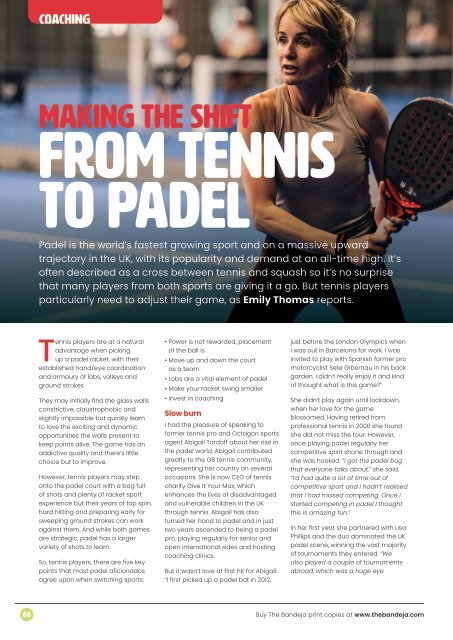The Bandeja summer 2024 issue
71 pages packed with padel news, insights, coaching, views, features, new products and more, including a competition to win a £295 Wilson padel racket. Enjoy reading the online version? Then pop over to our web shop at www.thebandeja.com to buy the 60-page print version.
71 pages packed with padel news, insights, coaching, views, features, new products and more, including a competition to win a £295 Wilson padel racket.
Enjoy reading the online version? Then pop over to our web shop at www.thebandeja.com to buy the 60-page print version.
You also want an ePaper? Increase the reach of your titles
YUMPU automatically turns print PDFs into web optimized ePapers that Google loves.
Making the shift<br />
from tennis<br />
to padel<br />
Padel is the world’s fastest growing sport and on a massive upward<br />
trajectory in the UK, with its popularity and demand at an all-time high. It’s<br />
often described as a cross between tennis and squash so it’s no surprise<br />
that many players from both sports are giving it a go. But tennis players<br />
particularly need to adjust their game, as Emily Thomas reports.<br />
Tennis players are at a natural<br />
advantage when picking<br />
up a padel racket, with their<br />
established hand/eye coordination<br />
and armoury of lobs, volleys and<br />
ground strokes<br />
<strong>The</strong>y may initially find the glass walls<br />
constrictive, claustrophobic and<br />
slightly impossible but quickly learn<br />
to love the exciting and dynamic<br />
opportunities the walls present to<br />
keep points alive. <strong>The</strong> game has an<br />
addictive quality and there’s little<br />
choice but to improve.<br />
However, tennis players may step<br />
onto the padel court with a bag full<br />
of shots and plenty of racket sport<br />
experience but their years of top spin,<br />
hard hitting and preparing early for<br />
sweeping ground strokes can work<br />
against them. And while both games<br />
are strategic, padel has a larger<br />
variety of shots to learn.<br />
So, tennis players, there are five key<br />
points that most padel aficionados<br />
agree upon when switching sports:<br />
• Power is not rewarded, placement<br />
of the ball is<br />
• Move up and down the court<br />
as a team.<br />
• Lobs are a vital element of padel<br />
• Make your racket swing smaller<br />
• Invest in coaching<br />
Slow burn<br />
I had the pleasure of speaking to<br />
former tennis pro and Octagon sports<br />
agent Abigail Tordoff about her rise in<br />
the padel world. Abigail contributed<br />
greatly to the GB tennis community,<br />
representing her country on several<br />
occasions. She is now CEO of tennis<br />
charity Give It Your Max, which<br />
enhances the lives of disadvantaged<br />
and vulnerable children in the UK<br />
through tennis. Abigail has also<br />
turned her hand to padel and in just<br />
two years ascended to being a padel<br />
pro, playing regularly for senior and<br />
open international sides and hosting<br />
coaching clinics.<br />
But it wasn’t love at first hit for Abigail:<br />
“I first picked up a padel bat in 2012,<br />
just before the London Olympics when<br />
I was out in Barcelona for work. I was<br />
invited to play with Spanish former pro<br />
motorcyclist Sete Gibernau in his back<br />
garden. I didn’t really enjoy it and kind<br />
of thought what is this game?”<br />
She didn’t play again until lockdown,<br />
when her love for the game<br />
blossomed. Having retired from<br />
professional tennis in 2000 she found<br />
she did not miss the tour. However,<br />
once playing padel regularly her<br />
competitive spirit shone through and<br />
she was hooked. “I got the padel bug<br />
that everyone talks about,” she said.<br />
“I’d had quite a lot of time out of<br />
competitive sport and I hadn’t realised<br />
that I had missed competing. Once I<br />
started competing in padel I thought<br />
this is amazing fun.”<br />
In her first year she partnered with Lisa<br />
Phillips and the duo dominated the UK<br />
padel scene, winning the vast majority<br />
of tournaments they entered. “We<br />
also played a couple of tournaments<br />
abroad, which was a huge eye<br />
As a tennis player<br />
“<br />
you think if you<br />
whack it hard<br />
enough they won’t<br />
get it back but to my<br />
initial surprise it kept<br />
coming back...<br />
”<br />
opener,” she said. She tries to play most<br />
days whether that be early in<br />
the morning, evenings or lunch breaks:<br />
“I work my padel sessions around my<br />
job and children, so it is a bit of<br />
a juggling act, but it is my passion<br />
and I absolutely love it.”<br />
Unlearning<br />
Tennis gives players a free pass into<br />
padel and Abigail’s game benefitted<br />
from years on the professional tennis<br />
tour. She acknowledged this ‘huge<br />
advantage’: “You have good hand eye<br />
coordination, you know how to volley,<br />
split step and move around the court<br />
and, most importantly, compete.”<br />
But even she had to unlearn some old<br />
tennis habits, as she explained: “As a<br />
tennis player you think if you whack<br />
it hard enough they won’t get it back<br />
but to my initial surprise it kept coming<br />
back.” A mental shift was required, with<br />
Abigail telling herself ‘you can’t whack<br />
this ball, less is definitely more in padel’.<br />
Room for two<br />
Abigail still loves tennis and believes<br />
the two sports can co-exist and<br />
complement each other. She’d like to<br />
see more tennis players make the shift,<br />
particularly semi-professionals nearing<br />
the end of their tennis journey, and is a<br />
firm advocate for getting more women<br />
and girls into padel.<br />
“<strong>The</strong>re are so many benefits both<br />
mentally and physically,” she said.<br />
“Especially when women get older,<br />
in terms of muscle loss, the benefit<br />
of playing any racquet sport is<br />
just so great.” •<br />
Abigail organises female-focussed<br />
coaching clinics through her company<br />
SET. For more information email<br />
hello@setpadel.club<br />
Shorter, flatter<br />
& off the glass<br />
Manchester Padel Club coach Rachel Thomas<br />
shares her top tips for making a successful<br />
transition from tennis to padel.<br />
1. Adapt shots and swings to the smaller court<br />
<strong>The</strong> smaller court in padel means there is much less time to prepare<br />
to hit the ball compared to tennis. This means your racket take-back<br />
needs to be shorter, a challenge for some players, particularly on the<br />
forehand where you can end up connecting with the ball later than<br />
intended. If you find that happening, focus on guiding the ball rather<br />
than hitting it.<br />
2. Reduce pace and topspin<br />
I would describe my tennis style of play as ‘aggressive baseliner’.<br />
I use topspin and pace on my groundstrokes to create an opportunity<br />
to go for a winner from the back of the court. In padel, this<br />
style of play is likely to lose you points. Pace and topspin<br />
can make the ball bounce higher, making it easier for<br />
your opponents to retrieve and counterattack. Instead,<br />
hit the ball flatter or with slice, which will cause it to<br />
bounce lower or die off the glass.<br />
3. Make use of the back glass<br />
<strong>The</strong> back glass can take some getting used to for<br />
players transitioning from tennis to padel. When I first<br />
started playing padel I would try and hit everything<br />
before the glass and end up hitting a difficult<br />
half volley, which would often lead to errors<br />
from me or an easy volley for my opponents.<br />
I’ve worked on this and now, by allowing<br />
the ball to hit the glass, I have more time<br />
to hit a better shot.<br />
4. Master the different<br />
overhead shots<br />
Mastering the different overhead<br />
shots in padel can be the difference<br />
between winning and losing. In tennis<br />
my strategy typically involves delivering<br />
a powerful smash to quickly conclude<br />
a point. In padel I use multiple overhead<br />
shots during a rally.<br />
Start by honing specific shots, such as the<br />
‘<strong>Bandeja</strong>’ and ‘Rulo’ overheads. Each of these<br />
shots demands a distinct technique and leads<br />
to a different outcome. Even after mastering<br />
them in practice, the decision-making process<br />
during a match scenario might take additional<br />
time. <strong>The</strong>refore, try and allow yourself the<br />
necessary time to make the right choice in<br />
the heat of the game. •<br />
66<br />
Buy <strong>The</strong> <strong>Bandeja</strong> print copies at www.thebandeja.com<br />
thebandeja.com | SUMMER <strong>2024</strong><br />
67




